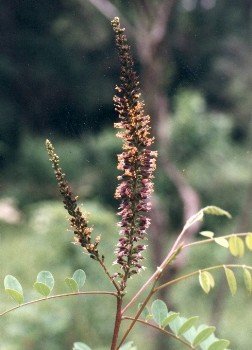False Indigo
by Valerie (November 7, 2002)
 For a brief time, early in our yard's history, we had a false indigo plant (Amorpha fruticosa). This plant has an awful lot of species synonyms, as well as several common names, including river locust, bastard indigo, and desert indigobush. Sources describe the plant with as much variation as the names would suggest. It is sometimes used as an ornamental but considered a noxious weed in the Pacific Northwest. I've seen it referred to as native and non-native, and invasive and non-invasive. It probably just depends on where it is growing. False indigo is a native shrub of the eastern U.S. and, although it prefers riparian habitats, it can also grow in dry areas. The most attractive feature of the plant is its blossoms, which are maroon colored with pink stamens tipped in gold pollen. The flowers appear in the spring and the smell is delightful.
For a brief time, early in our yard's history, we had a false indigo plant (Amorpha fruticosa). This plant has an awful lot of species synonyms, as well as several common names, including river locust, bastard indigo, and desert indigobush. Sources describe the plant with as much variation as the names would suggest. It is sometimes used as an ornamental but considered a noxious weed in the Pacific Northwest. I've seen it referred to as native and non-native, and invasive and non-invasive. It probably just depends on where it is growing. False indigo is a native shrub of the eastern U.S. and, although it prefers riparian habitats, it can also grow in dry areas. The most attractive feature of the plant is its blossoms, which are maroon colored with pink stamens tipped in gold pollen. The flowers appear in the spring and the smell is delightful.
Attracted by the flowers, I acquired a small plant and put it in our almost bare yard. It's single trunk quickly grew to about 5 feet tall, but as the number of leaves and branches increased, the trunk could not support it and it fell over. I staked it up, hoping that it would strengthen and be able to support its weight, but it never did. After only a couple years, I removed the plant as it looked a bit strange growing staked up in the middle of our lawn and not getting any taller. I did not realize that it is a shrub and should have had many slender stalks, instead of looking tree-like. It would now be an appropriate plant for our brushy wildflower areas and I'll probably reinstate it. |